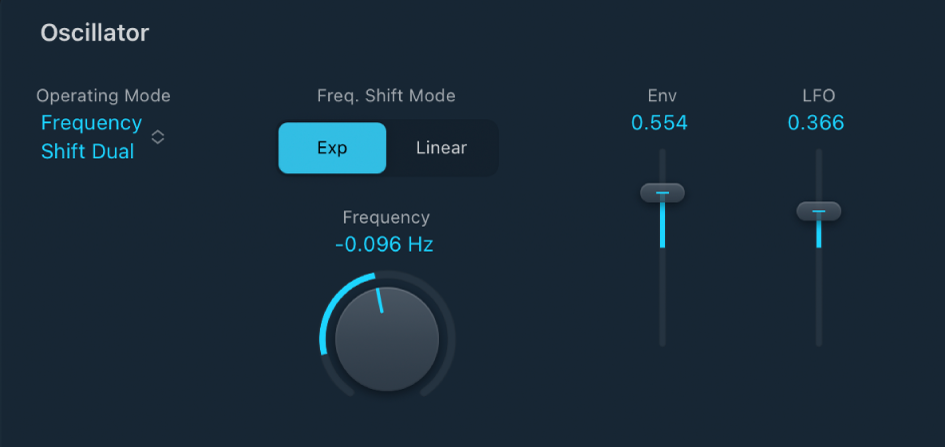Logic Pro User Guide for iPad
- What’s new in Logic Pro 1.1
-
- What is Logic Pro?
- Working areas
- Work with function buttons
- Work with numeric values
-
- Intro to tracks
- Create tracks
- Create tracks using drag and drop
- Choose the default region type for a software instrument track
- Select tracks
- Duplicate tracks
- Reorder tracks
- Rename tracks
- Change track icons
- Change track colors
- Use the tuner on an audio track
- Show the output track in the Tracks area
- Delete tracks
- Edit track parameters
- Start a Logic Pro subscription
- How to get help
-
- Intro to recording
-
- Before recording software instruments
- Record software instruments
- Record additional software instrument takes
- Record to multiple software instrument tracks
- Record multiple MIDI devices to multiple tracks
- Record software instruments and audio simultaneously
- Merge software instrument recordings
- Spot erase software instrument recordings
- Replace software instrument recordings
- Capture your most recent MIDI performance
- Use the metronome
- Use the count-in
-
- Intro to arranging
-
- Intro to regions
- Select regions
- Cut, copy, and paste regions
- Move regions
- Remove gaps between regions
- Delay region playback
- Trim regions
- Loop regions
- Repeat regions
- Mute regions
- Split and join regions
- Stretch regions
- Separate a MIDI region by note pitch
- Bounce regions in place
- Change the gain of audio regions
- Create regions in the Tracks area
- Convert a MIDI region to a Drummer region or a pattern region
- Rename regions
- Change the color of regions
- Delete regions
- Create fades on audio regions
- Access mixing functions using the Fader
-
- Intro to Step Sequencer
- Use Step Sequencer with Drum Machine Designer
- Record Step Sequencer patterns live
- Step record Step Sequencer patterns
- Load and save patterns
- Modify pattern playback
- Edit steps
- Edit rows
- Edit Step Sequencer pattern, row, and step settings in the inspector
- Customize Step Sequencer
-
- Effect plug-ins overview
-
- Instrument plug-ins overview
-
- ES2 overview
- Interface overview
-
- Modulation overview
-
- Vector Envelope overview
- Use Vector Envelope points
- Use Vector Envelope solo and sustain points
- Set Vector Envelope segment times
- Vector Envelope XY pad controls
- Vector Envelope Actions menu
- Vector Envelope loop controls
- Vector Envelope release phase behavior
- Vector Envelope point transition shapes
- Use Vector Envelope time scaling
- Use the Mod Pad
- Modulation source reference
- Via modulation source reference
-
- Sample Alchemy overview
- Interface overview
- Add source material
- Save a preset
- Edit mode
- Play modes
- Source overview
- Synthesis modes
- Granular controls
- Additive effects
- Additive effect controls
- Spectral effect
- Spectral effect controls
- Filter module
- Low and highpass filter
- Comb PM filter
- Downsampler filter
- FM filter
- Envelope generators
- Mod Matrix
- Modulation routing
- Motion mode
- Trim mode
- More menu
- Sampler
- Copyright
Ringshifter oscillator parameters in Logic Pro for iPad
In both frequency shifter modes and Ringmodulation Sine mode, the internal sine wave oscillator is used to modulate the amplitude of the input signal.
In the frequency shifter modes, the Frequency parameter controls the amount of frequency shifting, either up or down, applied to the input signal.
In Ringmodulation Sine mode, the Frequency parameter controls the frequency content, or timbre, of the resulting effect. This timbre can range from subtle tremolo effects to clangorous metallic sounds.

Oscillator parameters
Operating Mode pop-up menu: Choose an operating mode for Ringshifter:
Ringmodulation Sine: Enable to use the internal sine wave oscillator to modulate the input signal.
Ringmodulation Sidechain: Enable to modulate the amplitude of the input signal with the audio signal assigned via the side chain input.
The sine wave oscillator is switched off, and the Frequency controls are disabled when Side Chain mode is active.
Frequency Shift Single: Turn on to generate a single, shifted effect signal.
The oscillator Frequency control determines whether the signal is shifted to a positive value on the right side of the Frequency knob or to a negative value on the left side.
Frequency Shift Dual: Turn on to produce one shifted effect signal for each stereo channel—one is shifted up, the other is shifted down.
The oscillator Frequency control determines the shift direction towards the left or the right channel.
Freq Shift Mode buttons: Switch the scaling of the Frequency control.
Exp: Exponential scaling offers extremely small increments around the 0 point, which is useful for programming slow-moving phasing and tremolo effects.
Linear: Linear scaling is even across the entire control range.
 Frequency knob and field: Set the frequency of the sine oscillator.
Frequency knob and field: Set the frequency of the sine oscillator.Env slider and field: Determine the impact of incoming signal levels on the oscillator modulation depth.
LFO slider and field: Determine the amount of oscillator modulation by the LFO.
Download this guide: PDF